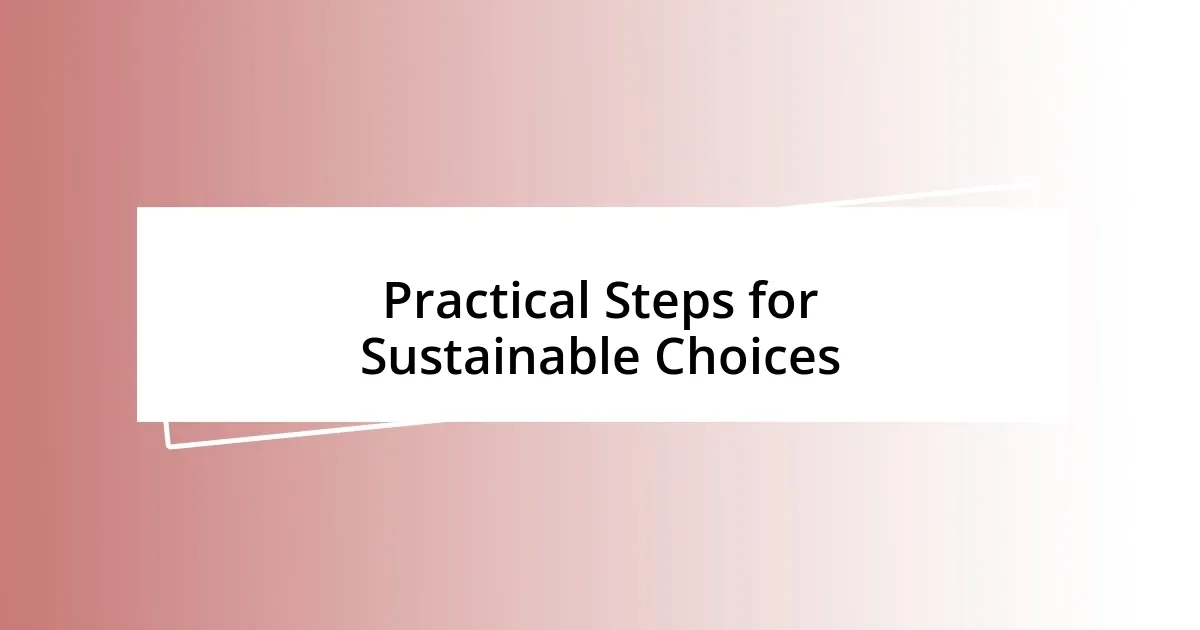Key takeaways:
- Fashion sustainability entails conscious choices that minimize environmental harm, such as opting for second-hand shopping and supporting eco-friendly brands.
- The fashion industry is a major polluter, responsible for significant water consumption, waste generation, and carbon emissions.
- Key principles of sustainable fashion include responsible sourcing, ethical labor practices, and focusing on durability and timelessness in clothing.
- Future trends highlight technology-driven solutions, circular fashion models, and increased transparency in supply chains as vital for sustainable progress in the industry.

Understanding Fashion Sustainability Basics
Fashion sustainability might sound like a buzzword, but it’s a fundamental shift in how we produce and consume clothing. I remember the first time I learned about the environmental impact of fast fashion—it was a wake-up call. Seeing that a single cotton t-shirt can require thousands of gallons of water made me question my own shopping habits.
Have you ever thought about where your clothes come from after you toss them aside? I used to overlook the lifecycle of my garments, but understanding that many fabrics can take years to decompose shifted my perspective. This realization led me to consider second-hand shopping and supporting brands committed to eco-friendly practices, which feel like small but meaningful actions toward positive change.
At its core, fashion sustainability is about making conscious choices that minimize harm to the planet. As I’ve explored this topic, I’ve developed a personal connection to brands that prioritize sustainable practices, which has enriched my wardrobe and my values. It’s fascinating to see how choices like using organic materials or implementing fair labor practices can transform not just the industry, but also my relationship with fashion itself.

Impact of Fashion on Environment
The impact of fashion on the environment is staggering and often overlooked. When I stumbled upon the fact that the fashion industry is one of the largest polluters globally, I felt a mixture of concern and responsibility. The truth is, the processes involved in producing our favorite garments can wreak havoc on our planet.
Here are some key environmental impacts of the fashion industry:
– Water Consumption: It takes around 2,700 liters of water to produce a single cotton t-shirt—enough for one person to drink for three years.
– Waste Generation: Approximately 92 million tons of textiles are disposed of each year, with a significant portion ending up in landfills.
– Chemical Pollution: The dyeing process often involves toxic chemicals that contaminate local water sources.
– Carbon Footprint: The fashion sector contributes about 10% of global carbon emissions, which is more than international flights and maritime shipping combined.
– Microplastics: Washing synthetic fibers releases microplastics into water systems, harming marine life and eventually entering the human food chain.
Reflecting on these facts, I couldn’t help but feel a responsibility to make informed choices in my fashion consumption. Each time I opt for a sustainable brand or a thrifted piece, it serves as a small act of rebellion against this damaging cycle. It’s empowering to realize that even our individual choices can drive the industry toward more responsible practices.

Key Principles of Sustainable Fashion
Understanding the key principles of sustainable fashion is essential for anyone who wishes to contribute positively to the industry. One of the first principles I came across is responsible sourcing. This means using materials that are grown or produced sustainably, such as organic cotton or Tencel, which comes from sustainably managed forests. At first, I had no idea how much my clothing choices could affect the environment, but embracing responsible sourcing has allowed me to make more informed decisions about my wardrobe.
Another critical principle is the focus on ethical labor practices. I vividly remember speaking with a friend who had firsthand experience working in a garment factory overseas. Hearing her stories about the conditions workers faced made me more conscious about supporting brands that ensure fair wages and safe working environments. It’s incredible to think how choosing to shop with ethical brands not only fosters respect for workers but also empowers them to create positive change in their communities.
Lastly, I believe that durability and timelessness are vital in sustainable fashion. I had the joy of discovering a small local brand that specializes in creating classic pieces meant to last for years. Instead of constantly chasing trends, investing in quality items that withstand the test of time has transformed how I view my wardrobe. I find satisfaction in curating a collection of well-made garments that not only minimizes waste but also brings me greater joy as I wear them time and again.
| Key Principle | Description |
|---|---|
| Responsible Sourcing | Using sustainable materials, such as organic cotton, to reduce environmental impact. |
| Ethical Labor Practices | Ensuring fair wages and safe working conditions for garment workers. |
| Durability and Timelessness | Investing in quality clothing designed to last rather than following fleeting trends. |

My Personal Framework for Sustainability
As I navigated my journey toward sustainability, I developed a personal framework centered on three core pillars: mindful consumption, educational engagement, and community support. Mindful consumption is essentially about understanding every purchase I make. Have you ever paused to consider where that shirt was made or the environmental cost behind it? I vividly recall a shopping trip where I chose not to buy a trendy piece after learning the brand’s practices. It feels empowering to take those extra moments to reflect before reaching for my wallet.
Educational engagement came naturally as I delved deeper into fashion sustainability. The more I learned, the more I realized how shared knowledge can open our eyes to the industry’s hidden truths. I remember a casual conversation with a friend who said, “I had no idea clothing could be so harmful!” That resonated with me because it highlighted the importance of spreading awareness. Every time I share insights about sustainable brands or eco-friendly practices, I feel like I’m contributing to a ripple effect of change.
Finally, community support ties my framework together. I’ve made it a priority to uplift local brands and initiatives dedicated to sustainability. Attending pop-up events and markets has truly enriched my experience. I recall meeting an inspiring designer whose mission was to create garments from recycled materials. Speaking with her made me realize that sustainability isn’t just a personal choice; it’s a collective movement we can all influence. How great is it to be part of something larger than ourselves? Being a part of this community has sparked deeper connections and a sense of belonging in my journey toward sustainable fashion.

Practical Steps for Sustainable Choices
When it comes to making sustainable fashion choices, I’ve found a few simple steps to integrate into my daily life. One of my favorites is thrifting. I remember the thrill I felt when I stumbled upon a vintage leather jacket at a local thrift store. It wasn’t just a unique find—it was also a small victory for sustainability by giving a second life to something that might otherwise have gone to waste. Have you ever experienced that rush of discovery while thrifting? It’s like a treasure hunt where every piece has a story.
Another step I embrace is making a list before shopping. It may sound mundane, but I’ve learned that going in with a plan helps me resist impulse buys. A few months ago, I set out with a specific goal: find a versatile dress. Instead of getting sidetracked by random trends, I stood strong and focused, eventually finding a classic piece that I adore. How often do we buy something we later regret? That moment reminded me just how much more meaningful a curated wardrobe can be.
Lastly, I’ve tried to educate myself on clothing care. I cherish a beautiful knitted sweater I bought a couple of years ago, and I treat it like gold—hand-washing it and air-drying it instead of tossing it in the dryer. I can’t help but smile every time I put it on, knowing I’m extending its life and reducing my overall footprint. Have you ever thought about how a little extra care can go a long way? Each time I wear it, I’m reminded that we can give our beloved pieces longevity, which feels like a small yet impactful win for sustainability.

Case Studies of Successful Brands
When I think about successful brands that embody sustainability, Patagonia instantly comes to mind. Their commitment to ethical sourcing and environmental activism has always inspired me. I still remember my excitement when I learned about their “Worn Wear” program, which encourages customers to repair and recycle their gear. It struck me that promoting longevity over consumption not only makes for a responsible brand image but also resonates with customers on a personal level. Have you ever stopped to consider the impact of a brand that actually wants you to buy less?
Another standout brand is Reformation, which has genuinely transformed my perspective on eco-conscious fashion. I was captivated by their transparent approach—showing the environmental impact of each product right on their site. It made me feel smarter in my purchasing decisions and more connected to the clothing I wore. I distinctly recall the moment I purchased a dress from them, knowing it was made from sustainable materials. I felt a rush of pride as if I was contributing to something bigger every time I wore it. Isn’t it refreshing to see a brand take responsibility like that?
Lastly, I can’t overlook the Italian brand Stella McCartney, known for integrating luxury with sustainability. I’ll never forget hearing her speak at a fashion conference, where she passionately discussed the importance of vegan materials and cruelty-free practices. It was inspiring to witness someone at the top of the fashion hierarchy advocating for change in a traditionally wasteful industry. Her vision made me reflect on my own fashion choices and how I, too, could aspire for a more sustainable wardrobe. Have you considered how luxury and responsibility can coalesce to create something extraordinary?

Future Trends in Fashion Sustainability
One of the most exhilarating future trends I see in fashion sustainability is the rise of technology-driven solutions. I remember when I first heard about 3D knitting technology that can produce garments with minimal waste. It felt like stepping into a new realm where creativity and sustainability go hand in hand. Could we soon find ourselves wearing custom-fit clothes produced right at home? The thought of being able to create something unique while minimizing my impact on the environment excites me!
Another trend I’m passionate about is the growing interest in circular fashion models. Companies will likely increasingly adopt practices that emphasize reusing materials, rather than simply discarding them. Recently, I experimented with upcycling old t-shirts into tote bags, and it was not just a fun project but also a way to reduce textile waste. Isn’t it rewarding to see discarded items transformed into something functional? This shift toward viewing clothing as a resource to be repurposed will deeply influence consumer attitudes and behaviors moving forward.
Lastly, I can’t help but feel hopeful about the increasing focus on transparency throughout the supply chain. I once attended a panel discussion where an industry leader spoke about traceability in fashion, and it struck me how crucial it is for consumers to know where their clothes come from. With brands starting to unveil their sourcing practices, I’m left wondering how this will reshape our buying decisions. Will we evolve to demand more from the brands we choose to support? I believe that as we become more conscious consumers, the pressure on brands to act responsibly will only intensify, paving the way for a more ethical fashion future.














